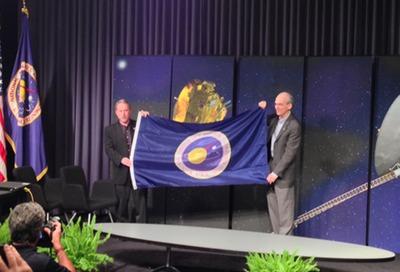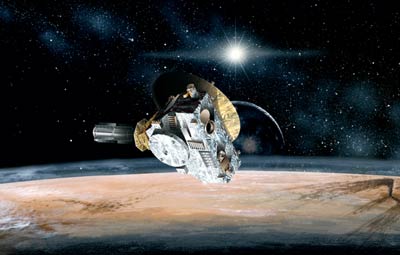A mission to Pluto enters the home stretchby Jeff Foust
|
| “Everything we know about the Pluto system today could probably fit on one piece of paper,” Stern said. “We don’t know a thing now and a year from now we’re going to write the textbooks.” |
The payoff, though, is worth the wait, as Rosetta’s science team is now discovering. For another mission, the anticipation of the wealth of discoveries awaiting them is growing. New Horizons, launched in January 2006 as the first mission to Pluto (see “A journey’s ending and beginning”, The Space Review, January 23, 2006), is now less than ten months away from its high-speed flyby of the distant world and its moons.
Last Monday, August 25, was a milestone of sorts for the mission. On that day, the spacecraft passed the orbit of Neptune, the last planet whose orbit the spacecraft will cross before its Pluto encounter next July. (Neptune itself was far from the spacecraft at the time of its orbit crossing.) By cosmic coincidence, that milestone took place 25 years to the day after Voyager 2 flew past Neptune, the last in its series of historic planetary flybys (see “The Grand Tour finale: Neptune”, The Space Review, August 25, 2014).
While there was no physical significance of the orbit crossing for the mission, the milestone, and its timing to the Voyager 2 anniversary, were otherwise significant enough for NASA to hold a press event at the agency’s Washington headquarters to look back at history while reminding the public of what’s to come with New Horizons next year.
Although New Horizons wasn’t near Neptune as it crossed its orbit—no closer than four billion kilometers—it still offered a very distant glimpse of that planet. “We thought it would be fun to use the spacecraft during its checkout this summer to make an image of Neptune and Triton, its large, planet-sized moon,” said Alan Stern, the principal investigator for the mission.
That image, not surprisingly, didn’t show much: Neptune was just a few pixels across, and Triton only one. “They’re so far away they’re only points of light,” he said. “That’s the power of going close.”
New Horizons, of course, will do far more than return images of points of light when it encounters Pluto next year. Although the spacecraft’s closest approach is July 14, the “encounter phase” of the mission starts in January. “Beginning in May, we exceed Hubble resolution,” Stern said, a reference to the best images of Pluto taken to date. “It will get better week by week” through the July flyby.
| “Flybys are very intense,” said Spencer. “You don’t know what to expect. You’re trying to imagine, yet you possibly can’t imagine, what you’re going to see. |
How much better? He showed an image of the Earth—specifically, New York City—at the same resolution as what New Horizons will achieve on its closest approach to Pluto. It showed enough detail to make out individual ponds in Central Park and piers on the Hudson River. “I don’t think we’re going to see any of that on Pluto,” he quipped, “but that’s the kind of detail that we’re going to have in the highest resolution—70 meters per pixel—images of the Pluto system.” That imagery is sharper, he said, than images from any other spacecraft “first reconnaissance” of another solar system body.
Stern promised that the images and other data collected during the flyby (which will takes months to return to Earth, given the limited data rates of the spacecraft at that distance) will revolutionize our understanding of Pluto. “Everything we know about the Pluto system today could probably fit on one piece of paper,” he said. “We don’t know a thing now and a year from now we’re going to write the textbooks.”
Less certain about New Horizons is what mission, if any, it will have after the Pluto flyby next July. Both NASA and project scientists have expressed an interest in using the spacecraft to fly past another icy body in the Kuiper Belt, but so far have not found any that would be in range of the spacecraft.
In June, the Space Telescope Science Institute granted time on Hubble to perform test observations to look for Kuiper Belt Objects (KBOs). If scientists could find at least two KBOs in those test observations, it would demonstrate that Hubble could be effectively used to look for potential targets for New Horizons, freeing up more time on the space telescope to conduct that search.
In early July, NASA announced the verdict from those tests: yes, Hubble could be effectively used to search for KBOs for New Horizons, having found at least two KBOs in the test images taken in June. The full survey involved Hubble observations in July and August.
At last week’s event, Stern said analysis of the images from that broader Hubble survey is ongoing. “The basic search is now complete,” he said. The hundreds of images taken in that survey has yielded some candidates, but Stern said it was too soon to tell if any of them are within range of the spacecraft. That determination will come after their orbits are refined though followup observations and additional analysis. “We hope to know before the year is out,” he said.
While New Horizons will be the first spacecraft to fly past Pluto, many on the science team are not newcomers to flybys. A number of scientists working on the mission were also involved with the Voyager mission, including Voyager 2’s final flyby exactly 25 years earlier. That experience gave them lessons for next year’s event.
“Flybys are very intense, particularly when, as often with flybys, it’s the first time you’ve been to that place,” said John Spencer of the Southwest Research Institute. “You don’t know what to expect. You’re trying to imagine, yet you possibly can’t imagine, what you’re going to see. And then it all happens so fast: you’re just blown away, and sort of dizzy for a long time afterwards.”
“In many ways, an encounter is almost like giving birth,” said Bonnie Buratti of JPL. “You go from an idea in your mind to a whole new person or a whole new world.”
“You also don’t get a lot of sleep,” added David Grinspoon of the Southwest Research Institute.
“That’s also true,” she said.
| “We all agree that this is one of the most fascinating places to explore,” Grinspoon said. The idea that a dwarf planet was not a class of planet—as current IAU definitions state—“to me is kind of silly.” |
The experience may be a little different at Pluto because New Horizons, unlike Voyager, will be gradually returning data for months, instead of all at once. “We’re going to have new Christmas presents under the tree for months after the encounter,” said Jeffrey Moore of NASA Ames. For example, he said, the detailed imagery needed to understand Pluto’s geology won’t be fully in hand until up to six months after the flyby. “It’s going to be the gift that keeps on giving.”
The Pluto flyby will also benefit from advances in technology, from the instrumentation on the spacecraft to how scientists will visualize and handle the data those instruments return. Also, noted Fran Bagenal of the University of Colorado, the New Horizons data will be available to the public immediately. “The data belong to everybody,” she said.
Any discussion of a mission to Pluto inevitably leads to a discussion of that world’s status in the solar system. When New Horizons was conceived, developed, and launched, Pluto was officially considered the solar system’s ninth planet. A little more than six months after launch, though, the International Astronomical Union (IAU) approved a new definition of the term “planet” that excludes Pluto, consigning it instead to a new class of bodies called “dwarf planets” (see “Inside the planet definition process”, The Space Review, September 11, 2006).
The question of Pluto’s status came up at the event in a rather odd way, though: via a question posed via Twitter by none other than actor William Shatner: “What can we do to get it’s [sic] planetary status back?” he asked, referring to Pluto. “There can’t be just 8 planets in our solar system.”
While many involved with New Horizons, particularly Stern, have been staunch supporters of continuing to call Pluto a planet, the panelists offered a more nuanced response. “The thing about the whole planet debate is that it was only necessary because we learned amazing things about Pluto,” responded Grinspoon. “We’re exploring this new realm of the solar system that we haven’t explored before, the realm of dwarf planets.”
“We all agree that this is one of the most fascinating places to explore,” he continued, “and we all agree that Pluto is a dwarf planet, which is a new class of object that we’re going to visit.” The idea that a dwarf planet was not a class of planet—as current IAU definitions state—“to me is kind of silly.”
 Alan Stern (left) and Ed Stone hold a NASA flag that flew at mission control during the Voyager flybys and will also fly at New Horizons missions control for next July’s Pluto flyby. (credit: J. Foust) |
Last week’s event was something of a passing of the torch from the Voyager flybys of the 1970s and ’80s to next year’s New Horizon flyby. It was also, more literally, a passing of a flag: after the televised portion of the event ended, Ed Stone, Voyager project scientist and former JPL director, formally handed over a NASA flag that flew in mission control during the Voyager mission to Stern. That flag will fly in New Horizons mission control during next year’s Pluto flyby.
And, while many of the scientists involved with New Horizons have experience with Voyager and other missions, the project also includes a number of young scientists for whom this will be their first mission. “Think about the next 25 years,” Stern said, “and ask yourself what missions will these scientists be principal investigators on in the 2040s? What will NASA and the United States and the world be doing to explore the universe then, with these scientists at the helm?”
